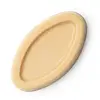What's inside
What's inside
 Key Ingredients
Key Ingredients

No key ingredients
 Benefits
Benefits

 Concerns
Concerns

 Ingredients Side-by-side
Ingredients Side-by-side

Theobroma Cacao Seed Butter
EmollientButyrospermum Parkii Butter
Skin ConditioningArgania Spinosa Kernel Oil
EmollientPhoenix Dactylifera Seed
Skin ConditioningRosa Rubiginosa Seed Oil
EmollientRosa Damascena Callus
AntimicrobialRosa Damascena Flower Oil
MaskingPelargonium Graveolens Oil
MaskingCitrus Limon Peel
MaskingAloe Barbadensis Leaf Extract
EmollientOpuntia Stricta Seed Oil
EmollientCitral
PerfumingCitronellol
PerfumingCoumarin
PerfumingGeraniol
PerfumingLimonene
PerfumingLinalool
PerfumingParfum
MaskingTheobroma Cacao Seed Butter, Butyrospermum Parkii Butter, Argania Spinosa Kernel Oil, Phoenix Dactylifera Seed, Rosa Rubiginosa Seed Oil, Rosa Damascena Callus, Rosa Damascena Flower Oil, Pelargonium Graveolens Oil, Citrus Limon Peel, Aloe Barbadensis Leaf Extract, Opuntia Stricta Seed Oil, Citral, Citronellol, Coumarin, Geraniol, Limonene, Linalool, Parfum
Water
Skin ConditioningSodium C14-16 Olefin Sulfonate
CleansingCocamidopropyl Betaine
CleansingGlycol Distearate
EmollientArgania Spinosa Kernel Oil
EmollientSodium Hydrolyzed Potato Starch Dodecenylsuccinate
Polyquaternium-22
Linoleamidopropyl Pg-Dimonium Chloride Phosphate
PEG-7 Amodimethicone
HumectantPolyquaternium-39
Laureth-4
EmulsifyingPEG-150 Pentaerythrityl Tetrastearate
EmulsifyingPPG-2 Hydroxyethyl Cocamide
EmulsifyingAcrylates/C10-30 Alkyl Acrylate Crosspolymer
Emulsion StabilisingPropylene Glycol
HumectantHexylene Glycol
EmulsifyingCitric Acid
BufferingSodium Citrate
BufferingSodium Hydroxide
BufferingSodium Benzoate
MaskingParfum
MaskingCI 19140
Cosmetic ColorantCI 16035
Cosmetic ColorantWater, Sodium C14-16 Olefin Sulfonate, Cocamidopropyl Betaine, Glycol Distearate, Argania Spinosa Kernel Oil, Sodium Hydrolyzed Potato Starch Dodecenylsuccinate, Polyquaternium-22, Linoleamidopropyl Pg-Dimonium Chloride Phosphate, PEG-7 Amodimethicone, Polyquaternium-39, Laureth-4, PEG-150 Pentaerythrityl Tetrastearate, PPG-2 Hydroxyethyl Cocamide, Acrylates/C10-30 Alkyl Acrylate Crosspolymer, Propylene Glycol, Hexylene Glycol, Citric Acid, Sodium Citrate, Sodium Hydroxide, Sodium Benzoate, Parfum, CI 19140, CI 16035
Ingredients Explained
These ingredients are found in both products.
Ingredients higher up in an ingredient list are typically present in a larger amount.
You may know this ingredient as argan oil. Argan Oil has antioxidant, hydrating, and soothing properties.
Studies have shown argan oil can help fight again radical damage from the sun. This makes it effective at preventing hyperpigmentation.
Large amounts of vitamin E found in argan oil helps the skin retain water. Argan oil also contains fatty acids such as linoleic acid, oleic acid, and palmitic acid. It is also a good source of lipids.
Another benefit of argan oil is skin-soothing. It can help reduce inflammation-related skin symptoms.
Argan Oil is effective at regulating sebum production in pores. This can make it effective at treating hormonal acne.
Traditionally, argan oil was used for its antibacterial and antifungal properties. However, argan oil contains fatty acids that may make it not fungal-acne safe.
Argan Trees are native to Morocco.
Learn more about Argania Spinosa Kernel OilParfum is a catch-all term for an ingredient or more that is used to give a scent to products.
Also called "fragrance", this ingredient can be a blend of hundreds of chemicals or plant oils. This means every product with "fragrance" or "parfum" in the ingredients list is a different mixture.
For instance, Habanolide is a proprietary trade name for a specific aroma chemical. When used as a fragrance ingredient in cosmetics, most aroma chemicals fall under the broad labeling category of “FRAGRANCE” or “PARFUM” according to EU and US regulations.
The term 'parfum' or 'fragrance' is not regulated in many countries. In many cases, it is up to the brand to define this term.
For instance, many brands choose to label themselves as "fragrance-free" because they are not using synthetic fragrances. However, their products may still contain ingredients such as essential oils that are considered a fragrance by INCI standards.
One example is Calendula flower extract. Calendula is an essential oil that still imparts a scent or 'fragrance'.
Depending on the blend, the ingredients in the mixture can cause allergies and sensitivities on the skin. Some ingredients that are known EU allergens include linalool and citronellol.
Parfum can also be used to mask or cover an unpleasant scent.
The bottom line is: not all fragrances/parfum/ingredients are created equally. If you are worried about fragrances, we recommend taking a closer look at an ingredient. And of course, we always recommend speaking with a professional.
Learn more about Parfum